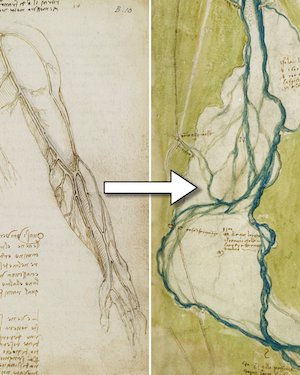Da Vinci took an idea that had been around for a thousand years and played with the idea that the human body is a scale model of Earth. Being Da Vinci he had a beautiful way of illustrating it.
Deep in his notebooks, Leonardo da Vinci had a mind-blowing idea:
— Culture Critic (@Culture_Crit) October 21, 2024
That the human body is a scale model of Earth.
And that's just the beginning — his theory will change the way you see everything… 🧵 pic.twitter.com/JwzG6ds3sd
The idea that the human body might reflect the structure of the Earth or the cosmos is not directly attributed to Leonardo da Vinci in the way some might assume, but he certainly explored the concept of microcosm and macrocosm, a philosophical notion popular during the Renaissance. Here’s how this relates to da Vinci:
- Vitruvian Man: Leonardo’s most famous exploration of these ideas is found in his drawing of the “Vitruvian Man,” where he depicts a man in two superimposed positions within a square and a circle. This drawing is inspired by the work of the ancient Roman architect Vitruvius, who wrote that the proportions of the human body could be used as a model for architectural proportions.
- Proportions: Leonardo was interested in how the human body could be geometrically inscribed within both a perfect circle and a square, suggesting a harmony between the human form and universal geometry.
- Microcosm and Macrocosm: The Renaissance saw a revival of interest in the idea that man is a microcosm of the universe. This concept suggests that the human body and the universe share similar patterns, structures, or laws.
- Leonardo’s notebooks show he was fascinated by the parallels between natural phenomena and human anatomy. For instance, he drew comparisons between the branching of blood vessels in the body and the branching of rivers on the Earth’s surface.
- Anatomical and Geological Studies: Leonardo conducted extensive studies in both human anatomy and geology. He might have seen similarities in the way systems work:
- Circulation: He compared the circulation of blood in the body to the circulation of water on Earth, noting how rivers could be seen as veins of the planet.
- Structure: He observed that the Earth has layers (like the crust, mantle, and core), and he might have drawn parallels to how the human body is structured with skin, muscle, and organs.
- Philosophical and Artistic Implications: Leonardo’s exploration of these themes wasn’t just scientific but also philosophical and artistic. He believed in understanding the universe through observation and analogy, where the human form could offer insights into the universal order.
While there isn’t a specific “theory” from da Vinci stating that the human body is a scale model of Earth, his works reflect a deep contemplation on the interconnectedness of all forms in nature. His holistic approach to science and art suggests he might have entertained the idea that the microcosm of human anatomy could inform or mirror the macrocosm of Earth’s systems, not in a literal sense but in terms of underlying principles and patterns.
This line of thought was more broadly part of the Hermetic tradition and alchemical thinking of the time, where “as above, so below” was a guiding principle, suggesting that what happens on one level of reality also happens on every other level. Leonardo’s work, while grounded in empirical observation, often danced with these philosophical undercurrents.
